Yellow Birds In Michigan
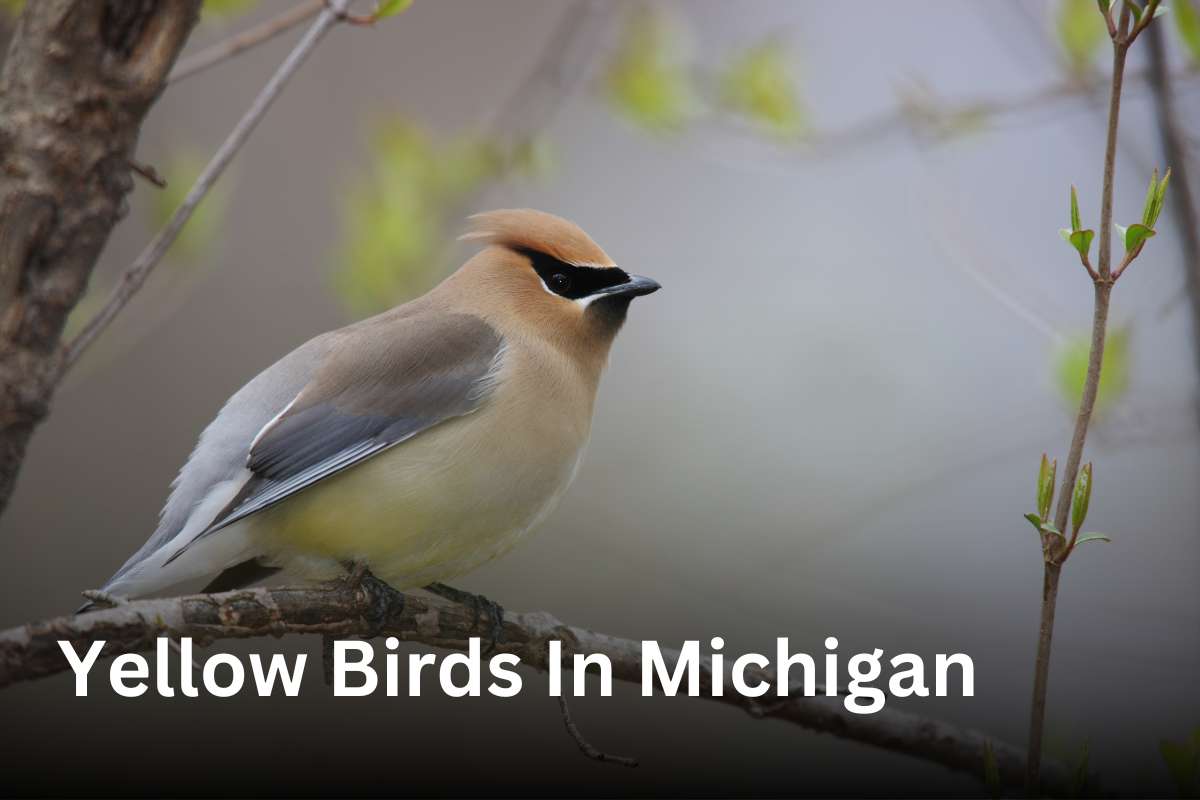
Michigan is a state that is in the Great Lakes region of the Upper Midwest region of the United States. It is home to over 456 species of birds in Michigan, as stated by the Michigan Bird Records Committee (MBRC).
From Magnolia Warblers to Cedar Waxwing, each species of yellow bird has a unique appearance. These fascinating birds are mainly found in backyards, gardens, forests, wetlands, parks, and open places.
Some species of yellow birds can be residents throughout the year. While the other species of birds may be part-time residents and migratory.
In this article, we will delve deep to learn about the unique characteristics, habitats, and nutritional diet of the top 15 yellow birds that are commonly found in Michigan state of the United States.
List of 15 Yellow Birds In Michigan
- Magnolia Warblers (Setophaga magnolia)
- Yellow-bellied flycatcher (Empidonax flaviventris)
- Kirtland’s warbler (Setophaga kirtlandii)
- Common yellowthroat (Geothlypis trichas)
- American Goldfinch (Spinus tristis)
- Yellow Warbler (Setophaga petechia)
- White-eyed Vireo (Vireo griseus)
- Yellow-breasted chat (Icteria virens)
- Nashville Warbler (Leiothlypis ruficapilla)
- Yellow-crowned night heron (Nyctanassa violacea)
- Evening Grosbeak (Hesperiphona vespertina)
- Palm Warbler (Setophaga palmarum)
- Hooded Oriole (Icterus cucullatus)
- Dickcissel (Spiza americana)
- Cedar Waxwing (Bombycilla cedrorum)
1. Magnolia Warblers (Setophaga magnolia)
It is a small New World Warbler species belonging to the Parulidae family. This bird can be easily distinguished by its coloration.
The breeding adults have yellow and black-striped stomachs and black tails with white strips. Overall, it has white, gray, and black backs with yellow on the sides and black foreheads and beaks.
The adult female and immature warblers have a small-billed with a gray head and gray band on the neck.
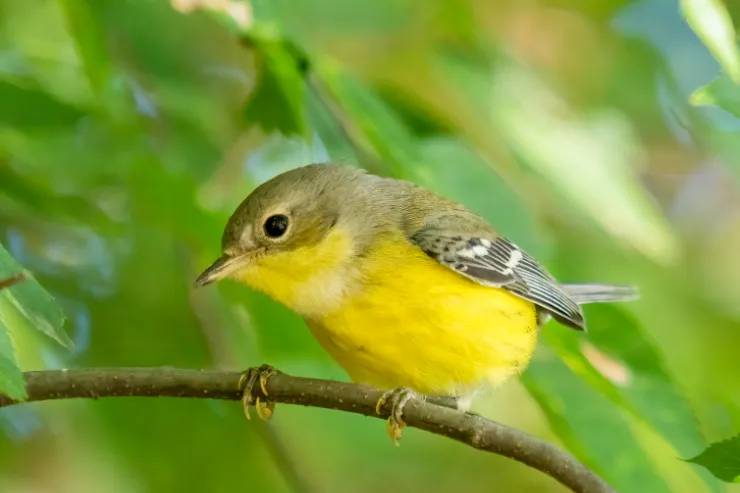
Size, Weight, Wingspan, Lifespan, and Breeding Period of Magnolia Warblers:
- Size: 4.3 to 5.1 inches (11 to 13 cm)
- Weight: 0.23 to 0.44 ounces (6.6 to 12.6 g)
- Wingspan: 6.3 to 7.9 inches (16 to 20 cm)
- Bill: 0.31 to 0.39 inches (0.8 to 1 cm)
- Lifespan: eight years
- Breeding Period: May to June
Magnolia Warblers‘ lifespan is expected to be eight years. However, their average lifespan is exactly not disclosed yet. The oldest Magnolia Warblers were recorded to be at least eight years and eleven months old.
As per the International Union for Conservation of Nature (IUCN) Red List has assessed the magnolia warbler as a least concern. The researchers surveyed to know the declining population of this bird.
This happens due to increased deforestation and dying at the time of flying into the television towers in their migratory path.
Habitat: The magnolia warbler is mostly found in dense forests, coniferous trees, and various woodlands. This warbler is also seen across the northern parts of Canada and the northeastern parts of the United States.
Feeding: Magnolia Warblers’ diet includes arthropods like butterflies, spiders, and beetles. During their breeding season, Warblers eat fruits.
In addition, they also increase their intake of both fruits and nectar during the winter season. But, their main diet includes caterpillars. Warblers also eat parts of the branches of mid-height coniferous trees.
2. Yellow-bellied Flycatcher (Empidonax flaviventris)
It is a small compact flycatcher bird that belongs to the family of Tyrannidae. Regarding their physical appearance, the adults have yellow underparts and green upperparts with a dusky wash on the chest.
The yellow-bellied flycatcher has a broad flat dark bill, white or yellow eye-ring, and wing bars that contrast strongly with the black wings. This species of flycatcher is a small insect-eating bird.
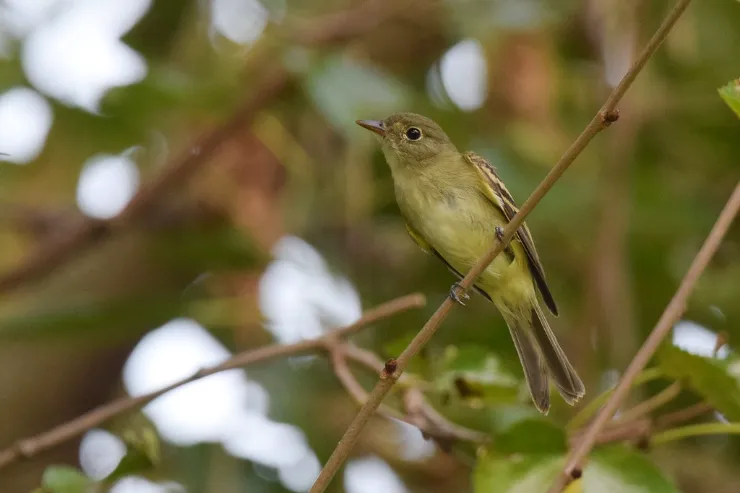
Size, Weight, Wingspan, Lifespan, and Breeding Period of Yellow-bellied Flycatcher:
- Size: 5.1 to 5.9 inches (13 to 15 cm)
- Weight: 0.3 to 0.6 ounces (8.5 to 17.0 g)
- Wingspan: 7.1 to 7.9 inches (18 to 20 cm)
- Lifespan: four years
- Breeding Period: June to July
The yellow-bellied flycatcher’s lifespan is expected to be four years. However, the oldest female yellow-bellied flycatcher was found to be at least five years and two months old.
The female flycatcher was recaught and released in 2009 during the banding operations in New York.
As of the latest information, it has been revealed that the IUCN Red List has assessed the yellow-bellied flycatcher as a species of low concern.
Habitat: A migratory bird migrating through southern Mexico and Central America. Their breeding habitat lies in the boreal coniferous forests, swamps, spruce bogs, and peatlands covered with thick moss and shrubs.
Feeding: Primarily, it forages on the low perches or in the middle of the tree to catch insects in midair or pluck them from vegetation. Occassionally, this bird eats berries or seeds.
On behalf of this, they also feed on caterpillars, stoneflies, spiders, crane flies, beetles, mosquitoes, and flying ants.
3. Kirtland’s warbler (Setophaga kirtlandii)
Commonly, the Kirtland’s warbler is also known as the jack pine warbler or the jack pine bird in Michigan. It is a small-sized songbird of the New World Warbler family.
The adult males have bluish-grey upper body parts with dark streaks on the back. They have yellow belly and throat. It also has a dark mark in front of the eye.
While the female and juvenile warblers have brown on the wings and at the back. The female warblers have thin white eye crescents.
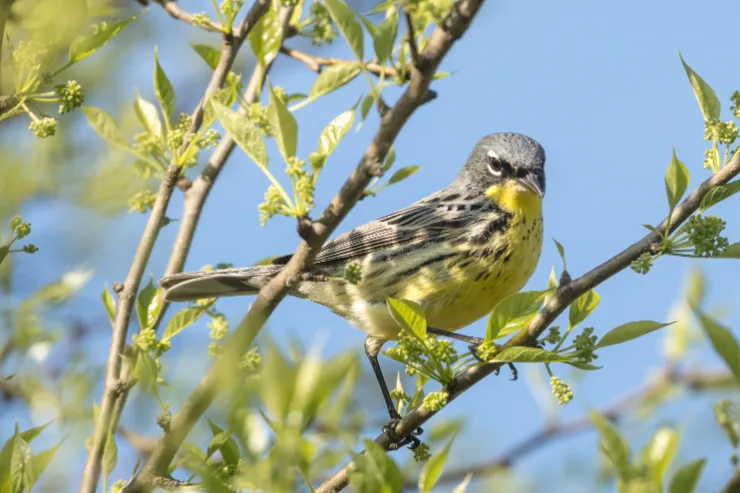
Size, Weight, Wingspan, Lifespan, and Breeding Period of Kirtland’s Warbler:
- Size: 5.5 to 5.9 inches (14 to 15 cm)
- Weight: 0.4 to 0.6 ounces (12 to 16 g)
- Wingspan: 22 cm (8.7 inches)
- Lifespan: Between 5 to 15 years
- Breeding Period: May to August
According to the IUCN Red List, the Kirtland’s warbler has been classified as vulnerable to extinction since 1994.
Later on, in 2005, it was listed as near threatened due to its recovery. The average lifespan of the Kirtland’s warbler is expected to be between five to fifteen years old.
Habitat: The Kirtland’s warbler is primarily found in low coppice habitat. During the summer season, it breeds in northern Michigan. It builds nests on the ground in young jack pine forests.
They can be found in the Upper Peninsula of Michigan, southern Ontario, Cuba (during the winter season), Hispaniola, and Wisconsin.
Feeding: Its main diet consists of insects, especially aphids, wasps, beetles, caterpillars, spittlebugs, ants, and fruits like blueberries.
4. Common yellowthroat (Geothlypis trichas)
This little bird has an olive back, yellow throats and chests, and white bellies. The common yellowthroat is also known as the yellow bandit or Maryland yellow-throat.
The adult male has a black face mask and a yellow throat with a round belly. The above part of the male yellowthroat is bordered with white or gray.
Meanwhile, the adult female has pale underparts with a yellow throat and breast. However, the black mask does not appear in the adult female. Likewise, the immature yellowthroat bird resembles similar with the adult female.
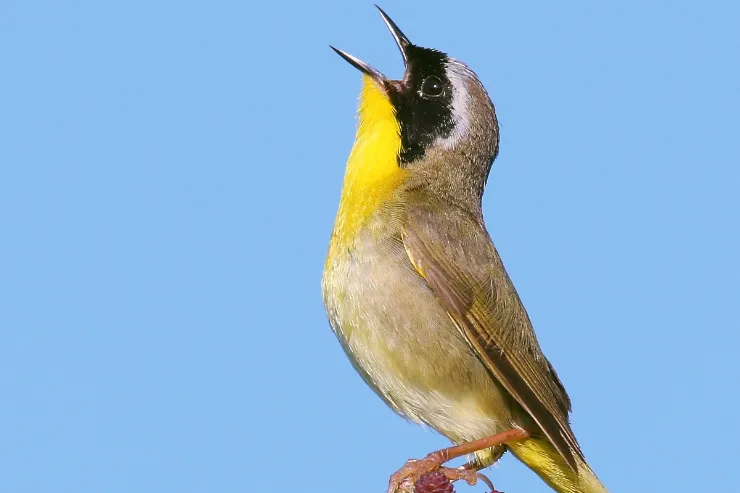
Size, Weight, Wingspan, Lifespan, and Breeding Period of Common Yellowthroat:
- Size: 11 to 13 centimeters (4.3 to 5.1 inches)
- Weight: 8.5 grams (0.3 ounces)
- Wingspan: 15 to 19 centimeters (5.9 to 7.5 inches)
- Lifespan: one to two years
- Breeding Period: late May to early July
The conservation status of the common yellowthroat is classified as a species of least concern. The population of this species of bird is declining due to the loss of favored habitat.
The average lifespan of a Common Yellowthroat is one to two years. But, this bird’s life expectancy can live up to 11 years. In the wild, the maximum longevity of the common yellowthroat bird is 11.5 years.
Habitat: This species of bird may be found in areas like marshes, dense low vegetation, primaries, and dense shrubs. They are less common in dry areas.
Being a nocturnal migrant, the common yellowthroat breeding habitat ranges in Central America and the West Indies and rarely in Western Europe.
Feeding: The small songbirds mainly consume insects. Such as dragonflies, beetles, grubs, small grasshoppers, moths, flies, spiders, aphids, and ants. It also eats seeds.
5. American Goldfinch (Spinus tristis)
It is a small-sized North American migratory bird that belongs to the family of Fringillidae. This bird has bright yellow feathers and black wings.
The little finch bird displays a sexual dichromatism character. The adult male finch is vibrant yellow during the summer and olive during the winter.
The coloration of the body changes by the carotenoid pigments due to the intake of plant materials. It is easily visible during flight. They have a short conical bill and a short notched tail.
Similarly, during the summer, the adult female is a dull yellow-brown shade which slightly brightens with a yellow bib. In addition, the immature finch bird’s underside is pale yellow and has a dull brown back.
Size, Weight, Wingspan, Lifespan, and Breeding Period of American Goldfinch:
- Size: 4.3 to 5.5 inches (11 to 14 cm)
- Weight: 0.39 to 0.71 ounces (11 to 20 g)
- Wingspan: 7.5 to 8.7 inches (19 to 22 cm)
- Bill or Culmen: 0.35 to 0.43 inches (0.9 to 1.1 cm)
- Lifespan: Up to 11 years (in the wild)
- Breeding Period: late June and early July (Sometimes it can also take place in late August or September)
In 2016, the survey was conducted by the IUCN Red List, the American Goldfinch has been classified as the least concern. The population of these species of birds is increasing rapidly every year.
In the wild, the American Goldfinch’s life expectancy is about 11 years. The oldest American Goldfinch was recorded to be at least 10 years and nine months old.
During a banding operation, this bird was recaptured and later on, it was re-released in Maryland.
Habitat: Generally, the American goldfinch prefers to live in open country. Such as meadows, flood plains, orchards, gardens, fields, and roadsides. It can also be found in riparian woodlands and open deciduous forests.
Feeding: In the world of avian, the researchers have claimed that the American Goldfinch is only a strictly vegetarian bird. The American goldfinch is mostly granivorous.
But, it feeds insects to the young ones occasionally to provide an additional supplement of protein. This bird is a diurnal feeder and its diet consists of weeds, seeds, grasses, and trees.
6. Yellow Warbler (Setophaga petechia)
One of the species of New World warbler species is the yellow warbler. This yellow-hued bird is widely spread in all parts of North America and northern South America.
The small-sized warblers have rounded heads with a black eye and stout bills. The breeding male bright yellow plumage and their overall body size are quite similar to all the warbler subspecies.
Similarly, the female warblers have beady black eyes, and a yellow body contrasting with a yellow-green back. This northern female warblers have unstreaked yellow underparts.
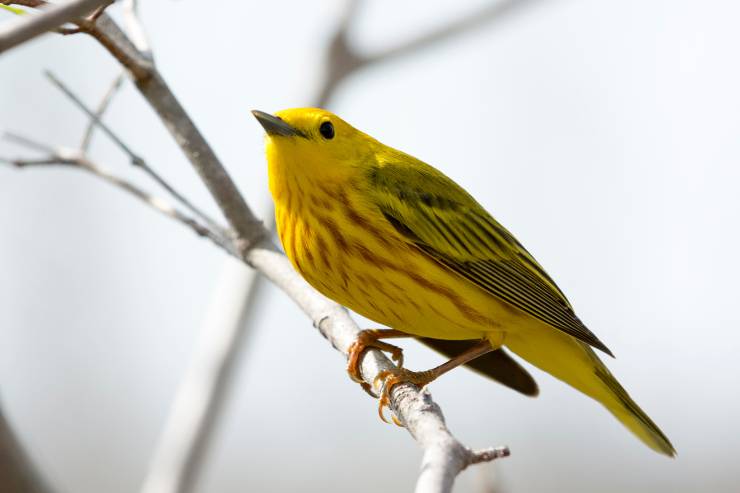
Size, Weight, Wingspan, Lifespan, and Breeding Period of Yellow Warbler:
- Size: 12.7 centimeters (5 inches)
- Weight: 9 to 11 grams (0.31 to 0.38 ounces)
- Wingspan: 16 to 20 centimeters (6.5 to 8 inches)
- Bill: 0.31 to 0.51 inches (0.8 to 1.3 cm)
- Lifespan: Up to nine years (in the wild)
- Breeding Period: May to June
The maximum longevity of the yellow warbler is recorded to be at least nine years and eleven months. In the wild, its average lifespan is up to nine years.
Due to its wide range, the conservation status of the yellow warbler is not classified as a threatened species by the IUCN Red List. The population size of this bird is legally protected by the Migratory Bird Treaty Act.
Habitat: The yellow warbler often migrates north to build its potential nest in the temperate, young forests, and shrublands from the Arctic Circle to Mexico.
In the winter season, it migrates to the mangrove forests. When the autumn season approaches, these warblers often migrate from South to Central and South America.
Feeding: Yellow Warblers have diverse diets. Their main diet consists of insects like caterpillars, spiders, beetles, and flies. During the winter season, it also consumes some kind of fruit.
7. White-eyed Vireo (Vireo griseus)
The white-eyed vireo is a small stocky songbird belonging to the family of Vireonidae. The adult bird has a straight thick hooked bill.
Overall, this vireo bird has a unique appearance, including a gray head contrasting with an olive-green back. It also has white irises that are surrounded by yellow spectacles.
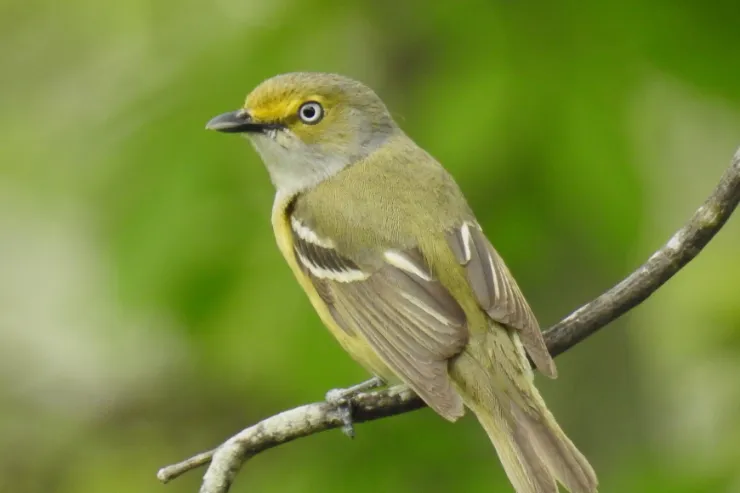
Size, Weight, Wingspan, Lifespan, and Breeding Period of White-eyed Vireo:
- Size: 11 to 13 cm (4.3 to 5.1 inches)
- Weight: 10 to 14 g (0.3 to 0.5 ounces)
- Wingspan: 17 cm (6.7 inches)
- Lifespan: 10 years
- Breeding Period: April to August
The white-eyed vireo lifespan is expected to be 10 years in the wild. However, the oldest male white-eyed vireo was recorded to live at least 10 years and 11 months old.
The conservation status of the white-eyed vireo is assessed as a species of least concern according to the IUCN Red List.
Habitat: The breeding habitat of the white-eyed vireo is found in the bushes and shrubs in overgrown pastures. It breeds in eastern Mexico, northern Central America, the Bahamas, and New England.
Feeding: This bird eats a wide variety of diets. It includes insects such as caterpillars, beetles, moths, spiders, leafhoppers, and butterflies.
During the winter and autumn, it eats berries and insects for additional supplements.
8. Yellow-breasted chat (Icteria virens)
The yellow-breasted chat is a large songbird that is most native to North America. Formerly, this bird was a member of the New World warbler family Parulidae.
But, in 2017, it moved to its own family of Icteriidae by the American Ornithological Society. This bird has a bright yellow throat and breast.
Overall, its upper part is olive with a contrast of white belly, black legs, and white eye rings. They have a long tail, big head, white spectacles, and mustache stripe.
The yellow-breasted chatbird is a variable mixture of whistles, hoots, clucks, and cackles.
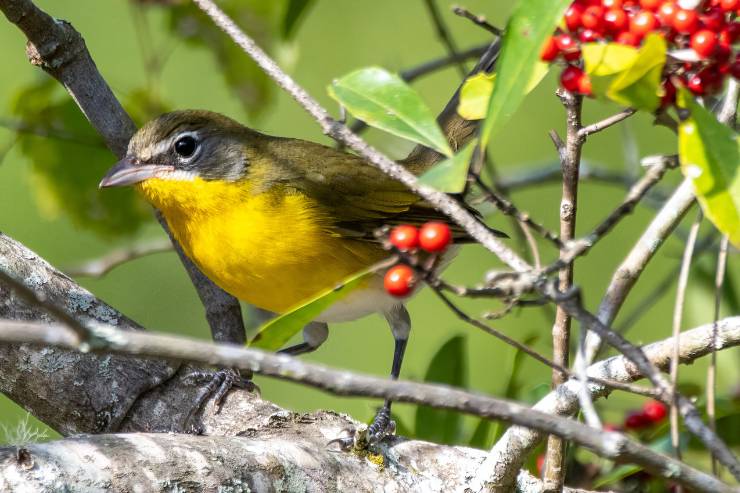
Size, Weight, Wingspan, Lifespan, and Breeding Period of Yellow-breasted chat:
- Size: 6.7 to 7.5 inches (17 to 19.1 cm)
- Weight: 0.71 to 1.19 ounces (20.2 to 33.8 g)
- Wingspan: 9.1 to 10.6 inches (23 to 27 cm)
- Bill: 0.51 to 0.63 inches (1.3 to 1.6 cm)
- Lifespan: 8.9 years
- Breeding Period: May to July
The oldest female yellow-breasted chat was recorded to live for at least 11 years and 11 months old.
In 2016, the female bird was spotted and recaptured at an Arizona banding station and later on, it was released in the same year. The average lifespan of the yellow-breasted chat can live up to 8.9 years in the wild.
As of now, the IUCN Red List has classified the yellow-breasted chat as a species of least concern.
Habitat: It is a migratory bird that mainly migrates to Mexico and Central America during the winter. Their breeding habitat ranges from the southern plains of Canada to central Mexico.
This beautiful yellow bird is a permanent resident throughout the year in North America. It can be easily spotted in thickets, powerline corridors, shrubs, and regrowing areas like bramble bushes.
Feeding: They are omnivorous birds. The yellow-breasted chat forages in the dense vegetation.
Typically, its diet consists of insects (like bugs, grasshoppers, spiders, weevils, beetles, tent caterpillars, wasps, ants, and moths), and berries.
9. Nashville Warbler (Leiothlypis ruficapilla)
The Nashville Warbler is a small warbler songbird that belongs to the family of Parulidae. This species of warbler is closely related to Lucy’s Warbler, Colima Warbler, and Virginia’s Warbler.
This little bird has a small rounded gray head, green back, yellow, and white underparts. Both sexes resemble the same physical appearance.
Adult male warblers have a yellow color that is visible below; but, the rusty brown patches on the chestnut crown are not usually clear and visible.

However, adult females and immature warblers have a dull olive-grey head and less bold yellow on their throats.
Size, Weight, Wingspan, Lifespan, and Breeding Period of Nashville Warbler:
- Size: 4.3 to 5.1 inches (11 to 13 cm)
- Weight: 0.2 to 0.5 ounces (5.7 to 14.2 g)
- Wingspan: 6.7 to 7.9 inches (17 to 20 cm)
- Lifespan: 10.2 years
- Breeding Period: April to May
In Ontario, the oldest Nashville Warbler was recorded to live for at least 10 years and two months. It is a warbler bird that is mainly protected by the United States Migratory Bird Act.
As of the latest information, the conservation status of the Nashville warblers is listed as a species of least concern by the IUCN Red List.
Habitat: Its breeding habitat ranges from Cote-Nord and Cape Breton Island in eastern Canada to central Alberta. This warbler migrates to Texas, California, mid-Mexico, and most of the northern parts of Central America.
It can be easily observed throughout the year in shrubby areas, open mixed woods, bog habitats, tamarack, and spruce.
Feeding: Generally, the Nashville Warbler diet includes insects and other arthropods. Specifically, these birds eat leafhoppers, caterpillars, beetles, flies, grasshoppers, and spruce budworms.
10. Yellow-crowned night heron (Nyctanassa violacea)
The yellow-crowned night heron is one of the species of the night heron that belongs to the family of Ardeidae.
In some parts of the world, this species of bird is often known as bihoreau violace in French and pedrete corona clara or yaboa comun in Spanish.
The adult night heron has a black and glossy head contrasting with white cheeks. It also has a pale yellow crown that extends from the black thick bill and yellow elongated legs.
Later on, the coloration of their long legs turns into coral, pink, or red during courtship.
Somewhat, the juveniles of the yellow-crowned night heron slightly resemble to the juvenile black-crowned night heron. In terms of their heavier bills, elongated legs, and with its fine streaks and spots.
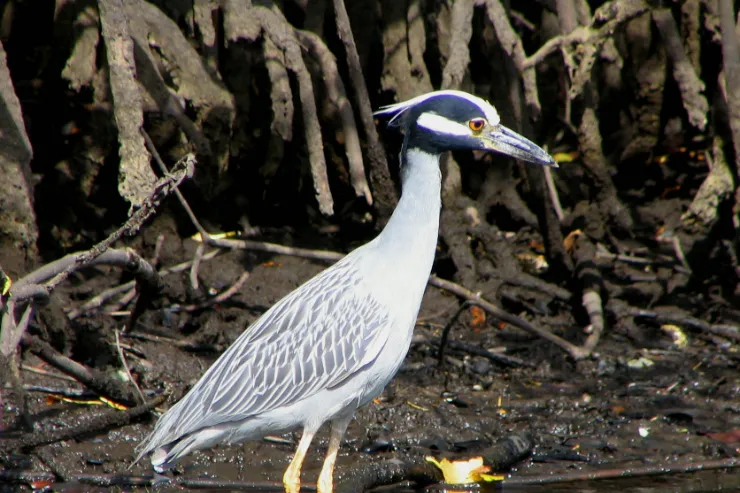
Size, Weight, Wingspan, Lifespan, and Breeding Period of Yellow-crowned night heron:
- Size: 55 to 70 cm (1 ft 10 inches to 2 ft 4 inches)
- Weight: 650 to 850 g (1.43 to 1.87 lbs)
- Wingspan: 101 to 112 cm (3 ft 4 inches to 3 ft 8 inches)
- Lifespan: six years
- Breeding Period: March to July
Due to its wide range and large population size, the conservation status of the yellow-crowned night heron is not considered a threatened species.
However, the IUCN Red List has classified this night heron bird as a species of least concern. The average life expectancy of the yellow-crowned night heron is about six years.
Habitat: This fascinating bird can be found in areas like shallow water where it can live in marshes, lakeshores, wooden swamps, mangroves, and thickets. Their habitat also occurs in freshwater, brackish water, and saltwater.
One of the most important habitat factors of the yellow-crowned night heron is nesting sites. It builds its potential nesting sites in the bushes or trees.
Feeding: The yellow-crowned night heron mainly eats crustaceans, insects, and crabs. Along with that, it also feeds on molluscs, lizards, amphibians, snakes, small birds, and small rodents. It forages both day and as well as night time.
At the time of foraging, this bird becomes very aggressive when another individual bird approaches closer to them. It tries to maintain a safe distance of about ten meters.
11. Evening Grosbeak (Hesperiphona vespertina)
A large finch bird belonging to the family Fringillidae is commonly found in North America. A passerine bird, evening grosbeak has a thick, large conical bill and short tail.
The adult male has a short black tail, bright yellow forehead, black wings along with a white patch on it, and a large pale bill.
The female bird is mostly olive-brown, grey on the underparts with a white patch in the wings. The immature bird is quite similar to the female evening grosbeak.
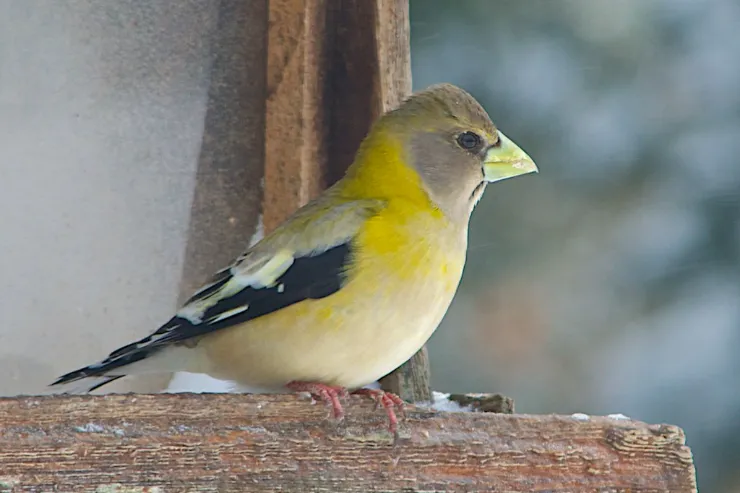
Size, Weight, Wingspan, Lifespan, and Breeding Period of Evening Grosbeak:
- Size: 16 to 22 cm (6.3 to 8.7 inches)
- Weight of male: 38.7 to 86.1 g (1.37 to 3.04 ounces)
- Weight of female: 43.2 to 73.5 g (1.52 to 2.59 ounces)
- Wingspan: 30 to 36 cm (12 to 14 inches)
- Bill: 1.6 to 2 cm (0.63 to 0.79 inches)
- Lifespan: 15 years
- Breeding Period: Early June to Late August
In 1974, the oldest male evening grosbeak was found and recorded to live for at least 16 years and three months old. The average life expectancy of the evening grosbeak is nearly 15 years.
As of the present data available, it has been observed that the IUCN Red List has classified the evening grosbeak as a species of vulnerable.
Habitat: This species is a migratory bird. Its breeding habitat can be found in coniferous and mixed forests across the mountainous areas of the western United States, Canada, and Mexico.
Since historical times, their breeding range has expanded eastward due to plantings of Manitoba maples.
During migration and winter, these birds are often seen in open, broadleaved forests. Likewise, especially ones with fruiting shrubs.
Feeding: This passerine bird forages in trees and bushes. Mainly, their primary diet consists of seeds, berries, and insects. It often migrates with a large flock of birds.
12. Palm Warbler (Setophaga palmarum)
The Palm Warbler is a small songbird that belongs to the family of Parulidae. This little songbird is well known for its brown and yellow coloring.
However, the coloration of this bird can vary between eastern and as well as western subspecies. The breeding adult has a round belly and rusty cap.
The warblers that reside in the eastern parts are entirely yellow with strong rust streaks on the breast.
They also have yellow eyebrows. While the stocky warblers in the western part have rusty caps, yellow undertails, pale eyebrows, and white bellies.
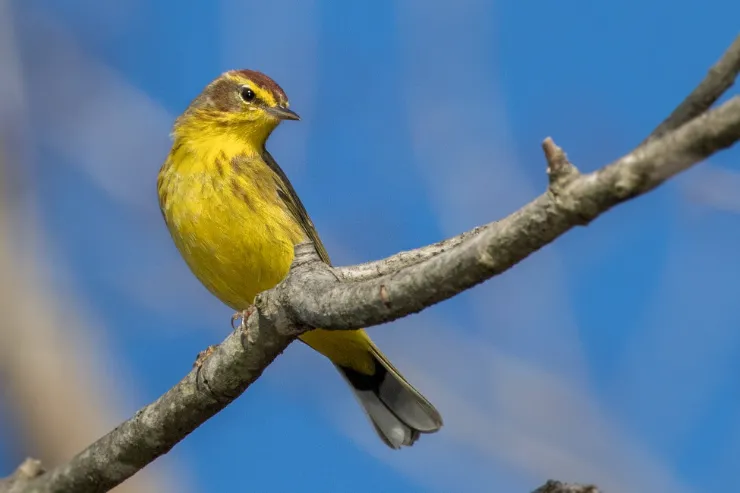
Size, Weight, Wingspan, Lifespan, and Breeding Period of the Palm Warbler:
- Size: 4.7 to 5.5 inches (12 to 14 cm)
- Weight: 0.3 to 0.5 ounces (8.5 to 14.2 g)
- Wingspan: 7.9 to 8.3 inches (20 to 21 cm)
- Lifespan: six years
- Breeding Period: Late April to Mid-May
It has been revealed that the oldest Palm Warbler was found to have lived for at least six years and seven months. Although the Palm Warbler’s average lifespan is expected to be six years.
As per the IUCN Red List, the conservation status of the Palm Warbler is assessed as a species of the least concern.
Habitat: Frequently, the Palm Warbler bird can be often spotted in forests, dry pine barrens, and open coniferous bog areas.
It is a migratory bird that migrates to the southeastern United States, the islands of the Caribbean, and eastern Nicaragua south to Panama in winter. But these species of birds are less vagrant to Iceland.
Feeding: The monotonous buzzy trill songbird, Palm Warbler mainly forages on the leaves of shrubs or low trees to catch or search for insects like flies, grasshoppers, caterpillars, mosquitoes, and berries.
During the winter season, it also feeds on seeds.
13. Hooded Oriole (Icterus cucullatus)
The hooded oriole is a medium-sized oriole bird belonging to the family Icteridae. The adult male songbird has a long and slender body than that of other orioles.
These birds have a curved bill that is entirely black and white wing bars. It has a deep yellowish-orange head with black on the face that extends up around its eyes and orange on the underparts.
While the female oriole birds are olive-green on the upper parts. They also encompass a yellow belly and breast, and unstreaked grayish back.

Size, Weight, Wingspan, Lifespan, and Breeding Period of the Hooded Oriole:
- Size: 7.1 to 7.9 inches (18 to 20 cm)
- Weight: 0.8 ounces (24 g)
- Wingspan: 23 to 28 cm (9.1 to 11.0 inches)
- Lifespan: three to five years (in the wild)
- Breeding Period: early April to early May
Hooded Oriole lifespan is expected to be three to five years in the wild. Later, it was found that the oldest species of hooded oriole lived for at least six years.
As per the IUCN Red List, this bird is listed as a species of the least concern.
Habitat: The hooded oriole breeding habitat is mainly found across the Southwestern United States and northern Mexico. Being a migratory bird, it migrates from south to Mexico’s southwestern coast in flocks.
Feeding: The oriole birds mainly eat fruits, insects, and nectar. Their diet includes a wide variety of insects such as beetles, wasps, caterpillars, and ants.
Hooded Orioles are acrobatic feeders that mostly feed nectar from the flowers and catch prey. These birds forage on the shrubs and trees.
It is known to be a common visitor to insects, hummingbird feeders, and bird feeders for seeds.
14. Dickcissel (Spiza americana)
These species of bird are a small seed-eating migratory bird that belongs to the Cardinalidae family. Dickcissels are somewhat large sparrow-like birds.
They have a large pale bill, brownish upperparts, and a yellow line over the eyes. The breeding adult males have a black throat patch, rusty shoulders, yellow breast, and grey crown and cheeks.
Likewise, the breeding adult females and juveniles have brown cheeks and crowns.
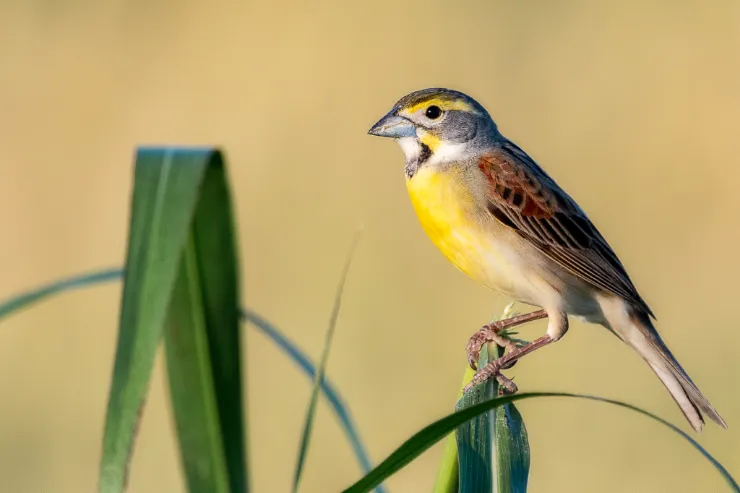
Size, Weight, Wingspan, Lifespan, and Breeding Period of the Dickcissel:
- Size: 5.5 to 6.3 in (14 to 16 cm)
- Weight: 0.9 to 1.4 ounces (25.6 to 38.4 g)
- Wingspan: 9.8 to 10.2 inches (24.8 to 26 cm)
- Lifespan: eight years
- Breeding Period: early June to mid-August
The dickcissel’s average life span is expected to be eight years. As of now, the conservation status of the dickcissel is listed as a species of the least concern by the IUCN Red List.
Habitat: Its breeding habitat lies in midwestern North America. Throughout the year, dickcissels are found in grassland habitats.
During the summer season, it can be common native in prairies and restored grasslands. In the northern part, the population size of the dickcissels is reduced by more than 1.5% from 1966 to 2015.
Feeding: The dickcissel diet mainly consists of insects and seeds, during breeding season. Such as caterpillars, termites, flies, wasps, beetles, and spiders. It forages on the open fields or the grounds.
During migration and winter, this bird eats seeds including grasses, willows, and buckwheat.
15. Cedar Waxwing (Bombycilla cedrorum)
The cedar waxwing is a medium-sized passerine bird belonging to the family Bombycillidae.
Overall, the physical appearance of this bird is remarkable by a silky shiny collection of brown, gray, and lemon-yellow, accented with a subdued crest, and a rakish black mask.
The tail of a waxwing bird has a yellow band at the tip and brilliant-red wax droplets on the wing feathers.
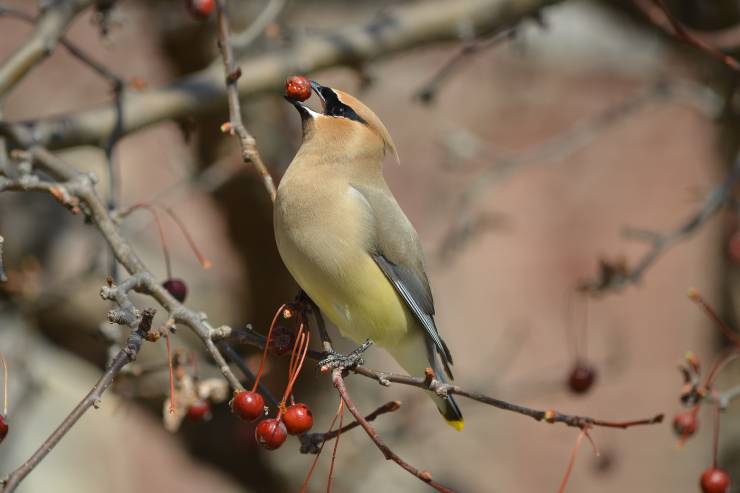
Size, Weight, Wingspan, Lifespan, and Breeding Period of the Cedar Waxwing:
- Size: 6 to 7 inches (15 to 18 cm)
- Weight: 30 g (1 ounce)
- Wingspan: 8.7 to 11.8 inches (22 to 30 cm)
- Lifespan: eight years
- Breeding Period: June to August
The conservation status of the cedar waxwing is listed as least concern by the International Union for Conservation of Nature (IUCN) Red List of Threatened Species. In the wild, the cedar waxwing birds can live up to eight years.
Habitat: Throughout the year, the vibrant colorful bird breeds in Michigan. Their breeding habitat occurs at the edge of wooded areas, forests, and fruiting trees.
During the winter season, they widely spread in the towns. Moreover, their habitat is mainly influenced by the availability of fruit trees and shrubs.
These birds can be spotted in parkland, golf courses, cemeteries, or other landscaping with well-spaced trees in urban and suburban environments. Where bushes provide berries and nearby water sources.
Feeding: Primarily, the cedar waxwing diet includes berries and sugary fruits over the year.
And, it has also been observed that insects are one of the important parts of their diet during breeding season. These lovely birds love to eat such overripened fruits and have begun to ferment.
During summer, they enjoy eating a variety of insects, such as beetles, ants, caterpillars, and flowers.
Conclusion:
In conclusion, yellow birds in Michigan significantly enhance the beauty of the state’s rich avian biodiversity. In Michigan, their vivid striking yellow plumage and attractive coloration make them popular across the state.
These colorful birds can be found in various habitats from woodlands and wetlands to suburban gardens.
These yellow birds are most seen during the spring and summer seasons. However, most of the species of yellow birds migrate to warmer regions during the fall and winter.
So, bird lovers as well as bird watchers have the best opportunity to observe these beautiful yellow-hued birds in the spring and summer in Michigan.






